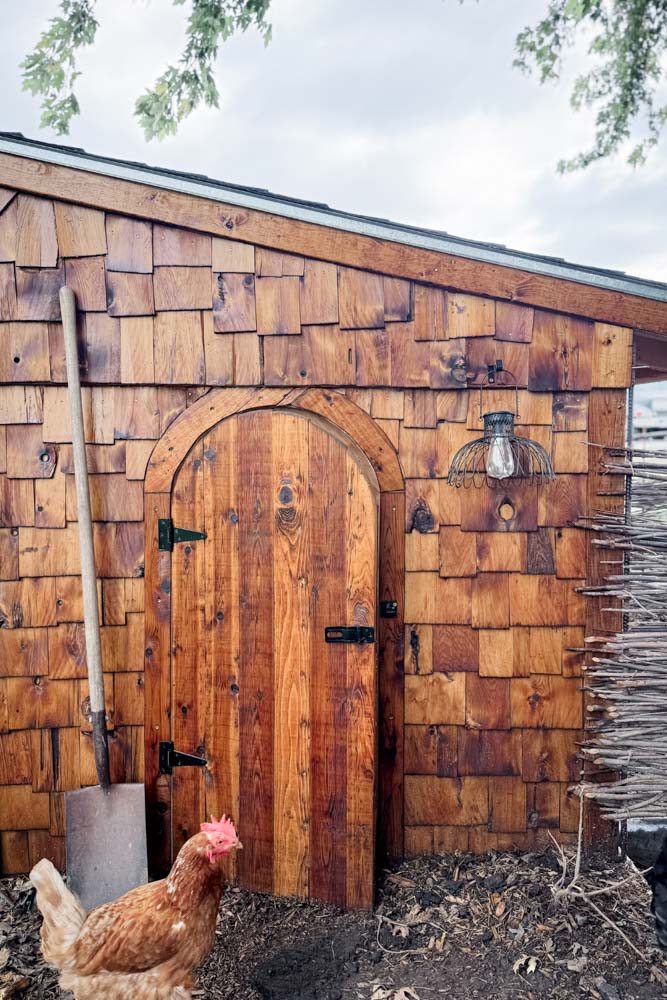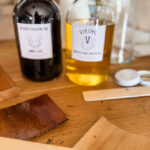Earth and Flax: Finishing Cedar the Old Way

Using Earth + Flax as my guide helped me lean more deeply into natural finishes, trusting cedar to age well and using products that work with the wood instead of coating over it.


Why Cedar Benefits from a Natural Finish
Cedar is already tough: it naturally resists rot, insects, and weather better than most woods. But cedar exposed to raw weather alone turns gray, dries out, and slowly loses its vibrancy. A natural finish—flax (linseed) oil, plus earth pigments or pine tar—restores warmth, enhances wood grain, and protects against UV, moisture, and insect damage. Earth + Flax emphasizes using purified linseed oil (rather than raw or boiled with unknown additives) to ensure proper absorption and durability.
- What is Linseed Oil?
- Earth Pigments and Pine Tar
- How to Mix and Apply
- How should I go about recoating and maintenance?
- Why we choose natural finishes

What is Linseed Oil?
Linseed Oil is oil from flax seeds and is classified as a penetrating finish, which better suits your outside wood projects. The oil base allows the finish to soak into the wood compared to a surface finish like polyurethane or shellac, which are recommended for indoor usage. Linseed oil enhances the natural beauty of your wood and when mixed with pine tar makes for a durable, breathable wood finish.
Earth Pigments & Pine Tar for Color & Protection
- Earth Pigments: Earth + Flax offers pigments like Burnt Umber that mix with purified linseed oil to create stains or tinted finishes for cedar that won’t look fake—letting wood’s natural texture show through.
- Pine Tar + Linseed Oil Mixtures: For deeper tones, more moisture/UV resistance, Earth + Flax’s “Authentic Pine Tar” mixed 50/50 with purified Viking Linseed Oil works well. Our combination is Dark Pine Tar and Linseed Oil. (The darker the pine tar, the better UV protection). They say this mixture (equal parts pine tar + linseed oil) gives great wood preservation: UV protection, some antiseptic/insect repellent qualities.


Mixing & Applying (Brush, Rag, Method)
Here’s how we used their suggestions:
- Surface Prep: Make sure cedar is clean, dry, and free of old coatings. Earth + Flax stresses that natural (barrier-forming) coatings must be removed so the wood can absorb oils properly.
- Primer coat (optional but helpful): If cedar is very dry (new wood or pressure treated), first coat with purified linseed oil alone to help the wood drink. It helps later coats adhere deeper.
- Mixing Pigment or Pine Tar: Mix pigment into linseed oil until smooth. For tar, the 50/50 pine tar + linseed oil mixture works. FYI this combination has a similar smell to when our smoker is cooking and I didn’t mind it!
- Application: Use a stiff-bristle brush or clean rag. Apply thin, even coats. With pine tar mixtures, brush out drips, avoid thick pooling. Work in a temp of ~60°F or warmer so oil/tar spread well and dry.
- Wipe Excess: After letting it soak for a short while (per Earth + Flax’s suggestions), wipe off excess oil/tar to avoid sticky or uneven surface finish.
Recoating Schedule & Maintenance
- Earth + Flax recommends 2 thin coats minimum when using pine tar + oil mixtures for exterior wood.
- Dry time: 48-72 hours between coats, in favorable weather (~60°F+). Lower temps slow curing.
- Maintenance every 8-10 years for heavier finishes (tar/oil combos). For simpler pigmented linseed oil or stains, you may notice dryness/fading sooner (1-2 years) and recoat as needed. Earth + Flax suggests gentle cleaning (non-petrochemical soap or linseed oil soap), letting wood dry fully before reapplying.
Instruction Card
Finishing Cedar with Earth and Flax
Ingredients
- Pine Tar + Linseed Oil Mixtures: For deeper tones more moisture/UV resistance, Earth + Flax’s “Authentic Pine Tar” mixed 50/50 with purified Viking Linseed Oil works well.
- Dark Pine Tar and Linseed Oil. The darker the pine tar, the better UV protection. They say this mixture (equal parts pine tar + linseed oil) gives great wood preservation: UV protection, some antiseptic/insect repellent qualities.
Instructions
- Surface Prep: Make sure cedar is clean, dry, and free of old coatings. Earth + Flax stresses that natural (barrier-forming) coatings must be removed so the wood can absorb oils properly.
- Primer coat (optional but helpful): If cedar is very dry (new wood or pressure treated), first coat with purified linseed oil alone to help the wood drink. It helps later coats adhere deeper.
- Mixing Pigment or Pine Tar: Mix pigment into linseed oil until smooth. For tar, the 50/50 pine tar + linseed oil mixture works.
- Application: Use a stiff-bristle brush or clean rag. Apply thin, even coats. With pine tar mixtures, brush out drips, avoid thick pooling. Work in a temp of ~60°F or warmer so oil/tar spread well and dry.
- Wipe Excess: After letting it soak for a short while (per Earth + Flax’s suggestions), wipe off excess oil/tar to avoid sticky or uneven surface finish.
Why Natural Finishes Age Beautifully
It’s easy to jump on the idea of a “natural” finish, but why is it actually a better option?
- They don’t form a brittle surface that peels or flakes. Earth + Flax notes that finishes like pine tar + linseed oil mellow over time (weathering, UV exposure) rather than cracking open.
- The color shifts slowly. Tar finishes protect first, then patina, then soften in color with seasons. Pigmented linseed oil stains deepen and mellow. Everything changes, but in a beautiful and predictable way.
- Because the finish penetrates wood fibers (rather than just sitting on top), cedar stays more nourished, more flexible, less brittle.
Final Thoughts
Using earth and flax-based finishes for cedar feels like carrying on something old and good. It takes more patience — thinner coats, longer drying — but the result is wood that shows its age with grace and strength. Cedar that wears its weather instead of being worn off. Use #HeartySolBuilds for your next project, I want to see what’s inspiring you!
More about the Coop Addition:
Learn how to create a Basic Roof using Asphalt Shingles
How to Construct a Rustic Fence using Wild Willow
Pin for Later!

Other projects we’ve completed
- How to Create Stylish Bi-Fold Closet Doors for Less
- How to Create a Faux Stone Wall
- The Magic of Cyanotype: Unraveling the World of Wearable Art

Affiliate Disclosure & Content Disclaimer
This post may contain affiliate links from a paid sponsor, Amazon or other program. When you use these links to make a purchase I earn a small commission at no extra cost to you. This allows me to continue creating the content that you love. The content in this article is created for information only and based on my research and/or opinion.
Emily T.
DAILY INSPIRATION ON THE GRAM @hearty.sol
it's hip to be square!

View comments
+ Leave a comment